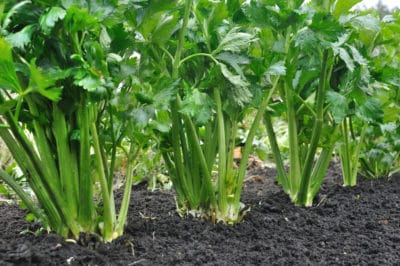About Companion Planting
The theory behind companion planting is to take advantage of plant characteristics that benefit one or both companion plants. Monocropping increases the risk of insect damage, since the whole bed is one kind of plant. Companion plants may be beneficial when growing celery. Others may simply be neutral or actually have antagonistic effects. Recommendations often vary according to gardeners’ experiences.
How Companion Planting Works
All plants secrete chemicals into the air and soil. Scientists think these chemicals may be the key to companion planting. For example, walnut trees secrete juglone, which actively repels other plants’ roots. Marigolds secrete chemicals that repel wireworms. In other cases, the chemicals attract beneficial insects, inhibit germinating seeds, repel insect predators or lure the insect predators away from susceptible plants.
Companions and Antagonists for Celery
The following plants seem to be beneficial when planted with celery. In some cases celery offers them benefits (see details below):
- Leeks
- Onions
- Cole family members like broccoli, cauliflower and cabbage
- Beans
- Spinach
- Cosmos
- Snapdragons
- Daisies
These are antagonistic to celery:
- Corn
- Irish potatoes
- Parsnips
- Related plants like carrots and parsley, which may carry diseases or attract insect pests.
Companion Plant Benefits
The actual benefits of a companion plant depend on the plant. Planting celery with cabbage protects the cabbage, as cabbage white butterflies dislike the scent of celery and are less likely to attack the cabbage plants. Flowers like cosmos attract helpful insect predators like parasitic wasps. Beans add nitrogen to the soil, benefiting the celery, which is a heavy feeder. Onions and their relatives are known to repel thrips.
Antagonist Plants
Some antagonist plants don’t actually harm the celery, but they may compete for nutrients. Corn, for example, is a heavy feeder. It’s also tall and can easily shade the celery so much it hampers growth. Corn and asters both increase the risk of your celery developing aster yellows disease. Some experts report that celery grown with tomatoes just doesn’t do well.
Art and Science
Companion planting is an area of gardening where the science lags far behind the area of practical knowledge. Companion planting may also work differently depending on garden conditions, especially soil types. The kinds of insects you’re dealing with also vary from one locality to another. This is an area where you’ll probably learn more by experimenting and keeping careful records than simply looking for a “recipe.”
